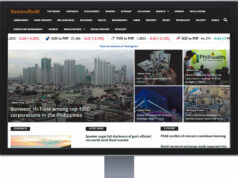By Adrian Paul B. Conoza, Special Features Writer
Meeting a greater demand for connectivity
Telcos, transportation, logistics see positive, digital-driven outlook
Connectivity has become more crucial when the coronavirus disease 2019 (COVID-19) pandemic restricted mobility. It halted public transportation for some time and disrupted logistics amid its continued operations, while pressing telcos to improve their services to meet a spiking demand.

With the economy proceeding into the new normal amid the ongoing battle against the pandemic, the reshaped telecommunications, transportation, and logistics sectors are expected to meet increased and intensified demands among consumers.
Addressing Internet issues
As the pandemic forced many to shift to remote work, online learning, and cashless banking, among others, it has further stressed that Internet connectivity is no longer a luxury but a necessity.
Ndiame Diop, World Bank’s (WB) country director for Brunei, Malaysia, Philippines and Thailand, regards Internet connectivity as the foundation of the digital economy. The problem, however, lies in the lack of digital infrastructure.
“Internet connectivity… is limited in rural areas, and where they are available, services are relatively expensive and of weak quality,” Mr. Diop was quoted as saying in a statement from the National Economic and Development Authority (NEDA), which partnered with WB in a recent report on digitalizing the Philippine economy.

“Upgrading digital infrastructure all over the country will introduce fundamental changes that can improve social service delivery, enhance resilience against shocks, and create more economic opportunities for all Filipinos,” Mr. Diop added.
Figures cited by NEDA and WB’s joint report show that the country’s mobile broadband speed is at 16.76 megabytes for second (mbps), much lower than the global average of 32.01 Mbps. 3G/4G mobile average download speed, meanwhile, stands at 7 Mbps, nearly half below the 13.26 Mbps in the entire Southeast Asian region.
Addressing these slow speeds is among the issues the telco industry has been tackling since the onset of the pandemic. With the Bayanihan to Recover As One Act simplifying the permit process for building cell towers, telcos are looking forward to better connectivity in remote areas.
“It is a real window of three years [of ushering] in a very real ‘Build, Build, Build’ for telcos and digital infrastructure,” Gil B. Genio, chief technology officer of Globe Telecom, Inc., stressed in a BusinessWorld Insights forum last September.
He added that if the country can build about 50 to 60 thousand cell towers in the next three years with the help of independent tower companies, coupled with intense competition among present players, “we will actually get to a decent kind of penetration for mobile Internet”.
In addition, Alfredo S. Panlilio, president and CEO of PLDT, Inc.’s wireless arm Smart Communications, Inc., noted that because of the pandemic, opportunities have opened up for the digital ecosystem to improve. As digital is further employed across industries, demand for Internet connectivity is expected to continue after the pandemic.
“Connectivity is best positioned as a frontline need for a very long time, and our goal for the near future is clear. We will continue to uphold customer centricity and adapt to various changes in the consumer mindset, having a good understanding of the way people live, work, play, and entertain themselves in this new normal,” Mr. Panlilio said during the BusinessWorld Virtual Economic Forum last November.
Transportation for individuals
As mobility has gradually revived after months of strict lockdown, transformation in transportation is observed, with an appreciation for ‘individual mobility’ and the push for transit-oriented developments (TODs) taking the lead.

Christophe Vicic, country head of JLL Philippines, proposed in the same online forum that TODs serve as one of the answers to the country’s transportation issues and, eventually, help direct the country towards improved connectivity.
“We’ll never be going back to [what was] before, but there will always be people transiting,” Mr. Vicic said, adding that TODs will attend people in transit by cutting commutes and reducing household spending.
As Mr. Vicic explained, TODs are characterized by walkable designs that prioritize pedestrians, train stations as a prominent feature, with public squares fronting these stations.
With these features, among others, TODs are set to be sustainable and eco-friendly, responding to ‘the clear message from the pandemic’: “We want a safer and healthier space to work and live, but we also want a healthier and safer way of working and living,” he said.
In addition, the pandemic has driven a rediscovered appreciation of individual mobility, according to Dr. Ting Wu, a partner of McKinsey & Company China.
“There’s going to be a balance. [We] believe the long-term transport, especially in major urban areas, [will] have a hub and spoke model where you have public transportation as the backbone,” Dr. Wu added.
“We do expect the world, across different geographies, to have a significant change of landscape in terms of transportation modes. Some are gearing more towards public transportation, some towards electric transportation, [while] some are towards shared micro-mobility,” he continued.
E-commerce boosting logistics
With an uptick in e-commerce, which is nonetheless enabled through connectivity, logistics is seen to support this trend. Steady growth is hence expected for the sector.

“[T]he logistics industry is one of the luckiest sectors, because there is still growth in that segment, and that’s because of the growth in e-commerce,” Sheila Lobien, executive officer of Lobien Realty Group, said in a BusinessWorld B-Side podcast last September.
She added that the sector is projected to grow by as much as 9% in the next three years, having observed that warehousing facilities and logistic support is needed to complement the growth in e-commerce.
Martin Cu, country head of Ninja Van Philippines, shared in the BusinessWorld Virtual Economic Forum what logistics will turn out to be post-COVID.
He sees an increasing client base in logistics, with more micro, small, and medium enterprises who are selling socially coming in. The sector is also expected to innovate delivery processes (e.g., same-day deliveries) while elevating safety protocols.
Moreover, Mr. Cu expects logistics to provide online sellers with business solutions that will meet their changing needs.
“We recognized that within Southeast Asia and across the sister countries that we have in Ninja Van, we can actually help by connecting our various sellers across this ecosystem and allow them to resupply very seamlessly,” Mr. Cu explained. “We have seen that that has been very valuable for a lot of shippers in terms of maintaining their businesses and their supply chain.”



